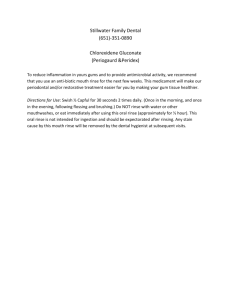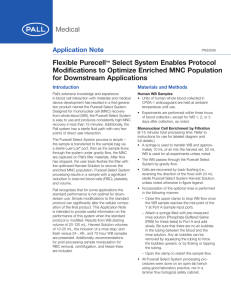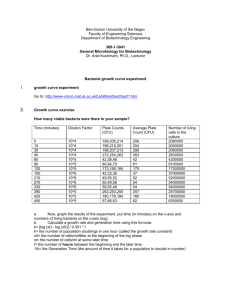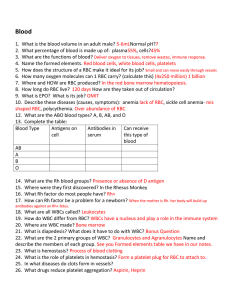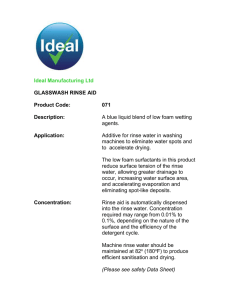Introduction
advertisement
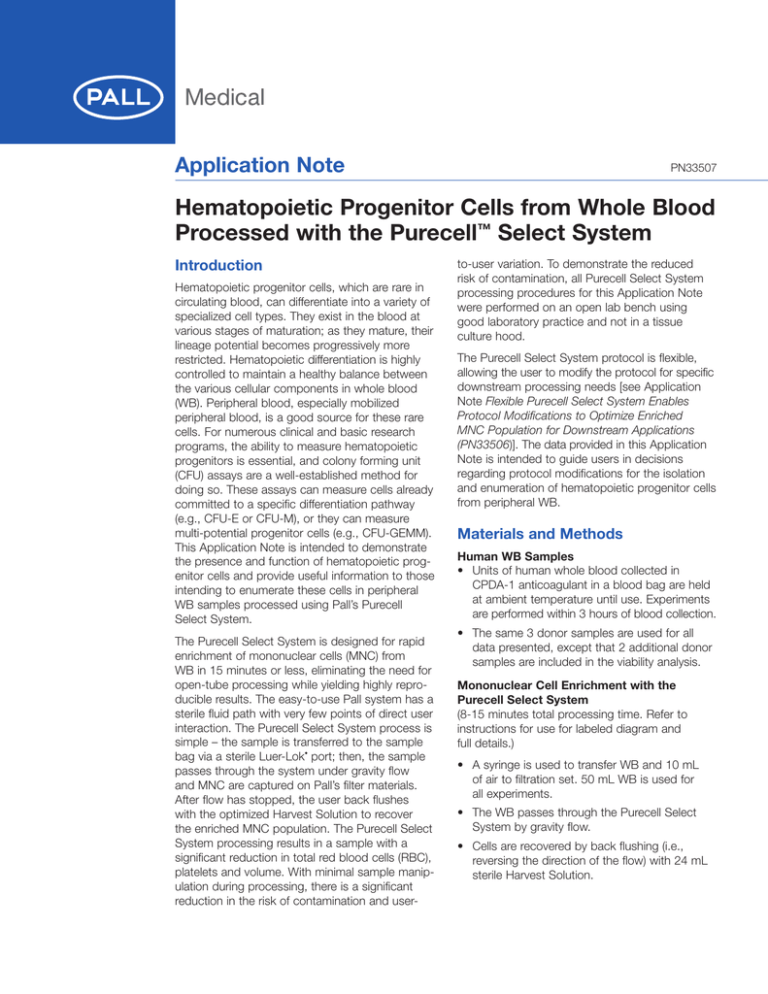
Application Note PN33507 Hematopoietic Progenitor Cells from Whole Blood Processed with the Purecell™ Select System Introduction Hematopoietic progenitor cells, which are rare in circulating blood, can differentiate into a variety of specialized cell types. They exist in the blood at various stages of maturation; as they mature, their lineage potential becomes progressively more restricted. Hematopoietic differentiation is highly controlled to maintain a healthy balance between the various cellular components in whole blood (WB). Peripheral blood, especially mobilized peripheral blood, is a good source for these rare cells. For numerous clinical and basic research programs, the ability to measure hematopoietic progenitors is essential, and colony forming unit (CFU) assays are a well-established method for doing so. These assays can measure cells already committed to a specific differentiation pathway (e.g., CFU-E or CFU-M), or they can measure multi-potential progenitor cells (e.g., CFU-GEMM). This Application Note is intended to demonstrate the presence and function of hematopoietic progenitor cells and provide useful information to those intending to enumerate these cells in peripheral WB samples processed using Pall’s Purecell Select System. The Purecell Select System is designed for rapid enrichment of mononuclear cells (MNC) from WB in 15 minutes or less, eliminating the need for open-tube processing while yielding highly reproducible results. The easy-to-use Pall system has a sterile fluid path with very few points of direct user interaction. The Purecell Select System process is simple – the sample is transferred to the sample bag via a sterile Luer-Lok port; then, the sample passes through the system under gravity flow and MNC are captured on Pall’s filter materials. After flow has stopped, the user back flushes with the optimized Harvest Solution to recover the enriched MNC population. The Purecell Select System processing results in a sample with a significant reduction in total red blood cells (RBC), platelets and volume. With minimal sample manipulation during processing, there is a significant reduction in the risk of contamination and user- to-user variation. To demonstrate the reduced risk of contamination, all Purecell Select System processing procedures for this Application Note were performed on an open lab bench using good laboratory practice and not in a tissue culture hood. The Purecell Select System protocol is flexible, allowing the user to modify the protocol for specific downstream processing needs [see Application Note Flexible Purecell Select System Enables Protocol Modifications to Optimize Enriched MNC Population for Downstream Applications (PN33506)]. The data provided in this Application Note is intended to guide users in decisions regarding protocol modifications for the isolation and enumeration of hematopoietic progenitor cells from peripheral WB. Materials and Methods Human WB Samples • Units of human whole blood collected in CPDA-1 anticoagulant in a blood bag are held at ambient temperature until use. Experiments are performed within 3 hours of blood collection. • The same 3 donor samples are used for all data presented, except that 2 additional donor samples are included in the viability analysis. Mononuclear Cell Enrichment with the Purecell Select System (8-15 minutes total processing time. Refer to instructions for use for labeled diagram and full details.) ◆ • A syringe is used to transfer WB and 10 mL of air to filtration set. 50 mL WB is used for all experiments. • The WB passes through the Purecell Select System by gravity flow. • Cells are recovered by back flushing (i.e., reversing the direction of the flow) with 24 mL sterile Harvest Solution. Materials and Methods (continued) • Incorporation of the optional rinse is performed to reduce the number of RBC and platelets in the following manner: – Stop the WB filtration by closing the Top Slide Clamp when the Sample Input Bag is emptied but the top of the fluid level has just reached the Y Connector at Port A (Sample Input Port). CFU Assays CFU assays (StemCell Technologies) are performed according to manufacturer’s instructions. Briefly: • Processed samples are resuspended at a concentration of 2 x 106 WBC/mL. • 300 µL of cell suspension is added to 3 mL of Complete Methocult. – Connect a pre-filled syringe to Port A, and slowly add rinse solution (PBS was used for these experiments). Be sure that there are no air bubbles in the tubing between the blood and the rinse solution. Any air bubbles can be removed by squeezing the tubing below Port A to force the bubble upwards or by flicking or tapping the tubing. • 1.1 mL of Methocult-cell suspension (2 x 105 WBC/dish) is added to each of two 35 mm culture dishes. – Open the Top Slide Clamp to restart the sample flow and continue filtration. Enumeration of CFU The CFU are counted using an inverted microscope (Olympus 1 x 51). Cultures are evaluated for the presence of erythroid, myeloid and multi-potential CFU as described in the technical manual, Human Colony-Forming Cell Assays Using Methocult (StemCell Technologies). – The remainder of the procedure is performed as described in the product’s instructions for use. • All Purecell Select System processing procedures were done on an open lab bench using good laboratory practice, not in a laminar flow biological safety cabinet. There were no apparent signs of contamination during the time cells were maintained in culture, ~2 weeks. No other sterility testing was performed. Mononuclear Cell Enrichment using Ficoll◆ Processing • 2 or 8 mL of WB is diluted 2-fold with PBS and carefully layered onto 3 or 10 mL Ficoll-Paque (GE Healthcare) in a sterile 15 or 50 mL tube (Falcon). ◆ • The tubes are centrifuged at 400 x g for 30 minutes at room temperature (RT) with the brake off. • The interface layer containing the mononuclear cells is removed and transferred to a clean tube and washed with 15 mL of sterile PBS. • The cells are centrifuged at 700 x g for 10 minutes. • The cell pellet is washed again with 15 mL PBS, and the cells are centrifuged at 700 x g for 10 minutes. • The final cell pellet is resuspended in PBS or Iscove’s Medium with 2% FBS (StemCell Technologies). NH4Cl Lysis of RBC for CFU Assays RBC depletion prior to cell culture is recommended. NH4Cl solution (StemCell Technologies) is used with slight modifications to manufacturer’s protocol. • 5 mL of WB or Purecell Select System processed cells are added to 20 mL of ice-cold NH4Cl solution (final ratio is 1:4, sample:lysis buffer). • The mixture is incubated on ice until lysis is complete (~10-15 minutes). • After lysis is complete, 25 mL of PBS with 2% FBS is added. The sample is centrifuged at 500 x g for 10 minutes. • The cell pellet is resuspended in 25 mL of PBS + 2% FBS and centrifuged for 10 minutes at 500 x g. • The final cell pellet is resuspended in Iscove’s Medium with 2% FBS. • Culture dishes are transferred to a tissue culture incubator at 37 ºC, 5% CO2 and 95% humidity. • The CFU are enumerated after 14-16 days in culture. • Erythroid CFU include Burst-Forming Unit-Erythroid (BFU-E) and Colony-Forming Unit-Erythroid (CFU-E). • Myeloid CFU include Colony-Forming Unit-Granulocyte (CFU-G), Colony-Forming Unit-Macrophage (CFU-M) and Colony-Forming Unit-Granulocyte, Macrophages (CFU-GM). • Multi-potential CFU include Colony-Forming Units with mixed populations of erythroid and myeloid cells (CFUGEMM). Normalization of CFU Counts to MNC The Purecell Select System samples contain a significant number of granulocytes that contribute to the final WBC count. In contrast, samples from WB processed by Ficoll typically contain very few granulocytes. The number of cells used in a typical CFU assay is based on the WBC, not the MNC counts. To directly compare the number of progenitor cells present in the MNC populations, CFU counts are normalized to the number of MNC where indicated. Cell counts are generated on a Cell-Dyn 1800 hematology analyzer (Abbott Labs) following standard protocols. Triplicate measurements are averaged for the concentrations of WBC, RBC and platelets. Percent recoveries are determined by calculating the number before and after the preparation using the following formula: ◆ Concentration of cells after isolation procedure x volume Concentration of cells before isolation procedure x WB volume x 100 Viability Determination Percent viability of WBC in the starting material and after Purecell Select System or Ficoll processing is determined by dye exclusion using propidium iodide (PI). • 50 µL of cell-containing samples, pre- and post-processing, are incubated in 1 mL 1 x H-lyse buffer (R&D Systems) for 18 minutes at RT. • 10 or 2 µL of PI (1 mg/mL, Molecular Probes) is added (except no stain controls) and incubated an additional 2 minutes at RT. • The cells are pelleted by centrifugation at 500 x g for 5 minutes, and then resuspended in 0.5 mL PBS. • Percent viability is determined by calculating the percentage of unstained versus total cells as determined by flow cytometry (BD FACSCalibur flow cytometer). ◆ Phenotype Analysis by Flow Cytometry Cell surface marker antibody staining followed by analysis with the FACSCalibur flow cytometer is performed using standard protocols. • Cells (0.5 x 106 in 0.1 mL) are incubated with fluorophoreconjugated-antibodies to the differentiation markers CD3, CD14, CD19, CD16+CD56, CD66b and CD45 (BD Biosciences) for T cells, monocytes, B cells, NK cells, granulocytes, and leukocytes, respectively for 20 minutes at RT. • At the end of incubation, RBC are lysed with 1 x H-lyse Buffer (R&D Systems) for 20 minutes at RT. • WBC are pelleted by centrifugation at 500 x g for 5 minutes, the supernatant is removed, and the cells resuspended in 0.5 mL PBS containing 2% serum. The percent positive for each of the surface markers in the WBC population is determined. The WBC count from the Cell-Dyn analyzer was used to calculate the total number of cells in each group using the following formula: (Concentration of WBC x volume x percent positive) = number of cells 100 in each group Results The presence of significant numbers of RBC makes the enumeration of rare cells difficult. Thus, an RBC reduction step is highly advisable. Incorporation of a rinse step in the standard protocol dramatically reduces the number of RBC in the Purecell Select System processed samples. (See Materials and Methods for more detail.) Alternatively, the RBC can be lysed with an NH4Cl solution; however, this exposure may damage some of the MNC. Percent Recovery of RBC, Platelets (plts), MNC and Granulocytes The addition of a rinse step to the standard protocol dramatically reduces the RBC numbers (Figure 1). The large reduction in RBC is clearly evident, with 86% depletion using the standard protocol (Purecell Select System). A further reduction in RBC can be obtained by incorporating a rinse step. Using 6 or 10 mL PBS rinses further reduces the RBC to approximately 94 and 97% depletion, respectively. The rinse step also further reduces the platelets from 71% depletion in the standard no-rinse protocol (Purecell Select System) to 89 and 95% depletion with 6 and 10 mL rinses respectively. The benefits of incorporating the rinse step become clear when comparing the commonly-used alternative method of RBC reduction, NH4Cl lysis. The effect that this chemical treatment has on the overall condition of nucleated rare cells is unknown. This step also adds considerable time to the procedure and yields equivalent CFU results (Figure 4). Ficoll density gradient preparation results in almost complete removal of RBC when using human WB, with variable reduction in platelets. Even though the percent recovery of MNC with the added rinse step is approximately 5-20% lower than the yields obtained with the standard no-rinse protocol, this reduction is less than that seen with the addition of an RBC lysis step (Figure 1 and data not shown). Figure 1 Effects of RBC Reduction Methods on Percent Recovery of Major WB Cellular Components Percent recovery of major cellular components based on WB starting material from RBC-lysed WB samples, Purecell Select System processed % Recovery from WB Sample Materials and Methods (continued) 80 70 60 50 40 30 20 10 0 RBC WB Lysed Platelet Purecell Select MNC Purecell Select Lysed Purecell Select 10 mL Rinse Granulocyte Purecell Select 6 mL Rinse Ficoll +/- rinse or RBC-lysed samples, and Ficoll processed samples shown here. RBC reduction using 6 or 10 mL rinse or lysis as indicated. Duplicates are averaged. Means +/- 1 standard deviation (SD) from 3 donors are reported. Results (continued) Cell Yield of Various Subpopulations A phenotypic analysis of these samples (average of 3 donors), WB starting material, Purecell Select System processed with or without RBC reduction, and Ficoll processed, indicated that the Pall process yields the highest number of all cell types (Figure 2). The addition of a rinse or RBC lysis step decreases the percent recovery of MNC subpopulations by 5-20%. The 10 mL rinse step results in a slightly greater reduction of granulocytes than an RBC lysis step (red versus yellow bars). The error bars represent donor-to-donor variability, not processing or analytical methods’ variability. Figure 2 Effect of RBC Reduction Methods on Yield of Major Leukocyte Populations Presence of Hematopoietic Progenitor Cells Using CFU Assay The presence of functional hematopoietic progenitor cells in the Purecell Select System processed samples is demonstrated using CFU assays. In particular, these assays show that progenitor cells in these samples maintain their ability to differentiate and proliferate in culture. Typical colony morphologies are observed in all Purecell Select System enriched, WB + RBC lysis, and Ficoll samples. Examples of erythroid (red) and myeloid (white) colonies are shown in Figure 3. Figure 3 Representative Hematopoietic Colonies from CFU Assays A B C D E F Cell Number x 106 160 120 80 40 0 T Cell WB B Cell WB Lysed NK Cell Monocyte Purecell Select Lysed Purecell Select Purecell Select 10 mL Rinse Purecell Select 6 mL Rinse Granulocyte Ficoll Cell number of major leukocyte populations from indicated samples. Duplicates are averaged. Means +/- 1 SD from 3 donors are reported. Cell Viability Cell viability from WB processing with the Purecell Select System using the standard protocol or the optional rinse step is equivalent or better than WB starting material (Table 1). An average of 90% viability was obtained with WB that had been processed using the standard protocol compared to 93-94% viable when the PBS rinse protocol was used. The incorporation of the NH4Cl RBC lysis, however, resulted in lower overall cell viability of 86%. Alternatively, Ficoll processing resulted in an average of 98% viable cells. Although Ficoll processing effectively removes dead cells, this method is extremely time consuming and yields fewer MNC and total cells. Table 1 Effect of RBC Reduction Methods on Viability Purecell Purecell Purecell Purecell Select Select Select Select Lysed 6 mL Rinse 10 mL Rinse Ficoll Average 85.3 84.9 90.0 86.0 92.9 94.2 97.5 SD 5.4 7.5 4.0 2.8 0.9 Samples WB 7.6 WB Lysed 7.6 Photos from Human CFU Assays (see Materials and Methods section for details) from indicated samples after 14-16 days in culture. 40x magnification for all samples except Purecell Select System without lysis (Figure 3A), which is magnified 100x. A. An erythroid BFU-E colony (red) and a myeloid CFU-GM colony (white) obtained from a standard Purecell Select System MNC harvest preparation that was not subjected to RBC reduction. B. BFU-E colony from Purecell Select System with 10 mL rinse. C. CFU-GM colony from Purecell Select System with 10 mL rinse. D. BFU-E and CFU-GM colonies Purecell Select System with 6 mL rinse. E. BFU-E and CFU-GM colonies obtained from a standard Purecell Select System preparation and lysed using NH4Cl. F. BFU-E colonies from NH4Cl lysed WB. Average WBC viability (PI) of samples processed as indicated. Means +/- 1 SD from 5 donors are reported. www.pall.com/celltherapy Results (continued) Conclusions The residual RBC in the Purecell Select System samples without RBC reduction makes the enumeration of both erythroid and myeloid colonies difficult due to high background (Figure 3A). The addition of the optional 10 or 6 mL rinse step significantly reduces the background, thus improving accuracy of the colony count data (Figures 3B, 3C, and 3D). Although the 6 mL rinse sample has a greater number of RBC visible on the plate, enumeration is not a problem. It is important to note however, that although there is a slight granular background in samples with the rinse step as compared to samples with an RBC lysis step, it does not interfere with colony identification or count (Figures 3E and 3F). The overall colony numbers obtained with the Purecell Select System samples with rinse or RBC lysis and Ficoll processing are very similar (Figure 4). Colony numbers are reported based on seeding the cultures with 2 x 105 WBC/plate and normalized to number of MNC/plate. Given the overall CFU results, the choice of RBC reduction method can be based on convenience factors, i.e., speed, rather than performance factors. Even though the rinse step results in an approximately 5-20% decrease in overall MNC recovery, hematopoietic progenitor cells do not appear to be adversely affected. Pall’s Purecell Select System provides fast, simple WB processing with high MNC recovery. In addition, the Pall system eliminates open-tube processing, therefore minimizing risk of contamination. The presence of rare hematopoietic progenitor cells in processed samples is demonstrated using CFU assays. RBC reduction is recommended if processed cells will be used in CFU or other culture-based systems. RBC are significantly reduced with the incorporation of an optional rinse step or using a traditional NH4Cl lysis solution. Although both methods result in a decrease in MNC recovery, overall CFU numbers are similar. The demonstration of hematopoietic progenitor cell functional capacity (proliferation and differentiation) suggests that the Purecell Select System does not damage cells, and thus is likely to yield equally unaffected functional cells of all types. Purecell Select System MNC recovery is much higher when no RBC reduction is used; thus, it is reasonable to predict that the total number of CFU would also be higher without RBC reduction. The enrichment of MNC and rare hematopoietic progenitors combined with attributes important in research environments (e.g., rapid, robust, sterile processing), suggest that Pall’s Purecell Select System has a great potential for routine use in research laboratories. Number of CFU per 2 x 105 Cells Figure 4 Effect of RBC Reduction Methods on Human CFU Assays 60 40 20 0 CFU/WBC CFU/MNC CFU/WBC CFU/MNC CFU/WBC CFU/MNC Erythroid WB Lysed Myeloid Purecell Select Lysed Purecell Select 10 mL Rinse Mixed Purecell Select 6 mL Rinse Ficoll CFU number, per 2 x 105 WBC or normalized to MNC, for erythroid, myeloid, and mixed colonies from samples processed as indicated. Means +/- 1 SD from 3 donors are reported. www.pall.com/celltherapy www.pall.com/celltherapy Pall Medical - Cell Therapy 600 South Wagner Road Ann Arbor, MI 48103-9019 USA Australia - Cheltenham, VIC Tel: 03 9584 8100 1800 635 082 (in Australia) Fax: 1800 226 825 India - Mumbai Tel: +91 22 67995555 or +91 22 66830700 Fax: +91 22 67995556 800.521.1520 734.665.0651 734.913.6495 Stem_Cells@Pall.com Brazil - Rio de Janeiro Tel: (5521) 2111.92.08 Fax: (5521) 2111.92.05 Korea - Seoul Tel: 82-2-560-8711 Fax: 82-2-569-9095 Canada - Ontario Tel: 905-542-0330 800-263-5910 (in Canada) Fax: 905-542-0331 Thailand - Bangkok Tel: (66) 2937 1055 Fax: (66) 2937 1066 toll-free in USA phone fax email Canada - Québec Tel: 514-332-7255 800-435-6266 (in Canada) Germany - Dreieich Tel: 06103-307 333 Fax: 06103-307 399 United Kingdom - Portsmouth Tel: +44 (0)23 9230 3452 Fax: +44 (0)23 9230 3324 Biosvc@Pall.com United States - California Tel: 626.339.7388 Fax: 626.858.0458 Stem_Cells@Pall.com © 2008, Pall Corporation. Pall, , and Purecell are trademarks of Pall Corporation. ® indicates a trademark registered in the USA. ◆Ficoll and Ficoll-Paque are trademarks of GE Healthcare Bio-Sciences. Cell-Dyn is a trademark of Abbott Laboratories. BD FACSCalibur is a trademark of BD Biosciences. Luer-Lok is a trademark of Becton-Dickinson. This product, and its use, may be covered by one or more patents including US 6,544,751; EP 973,587. 1/09, 1.5K, GN08.2354 PN33507




